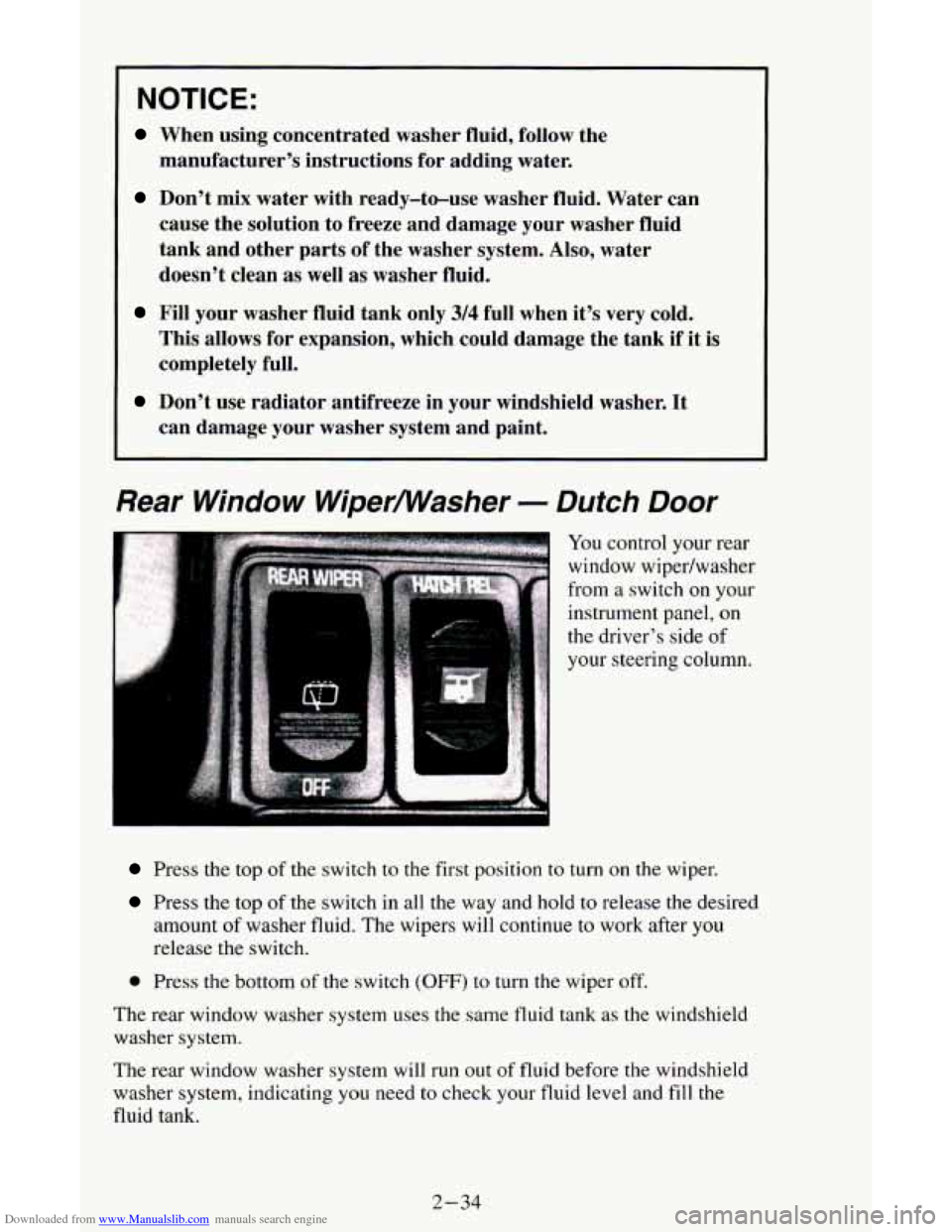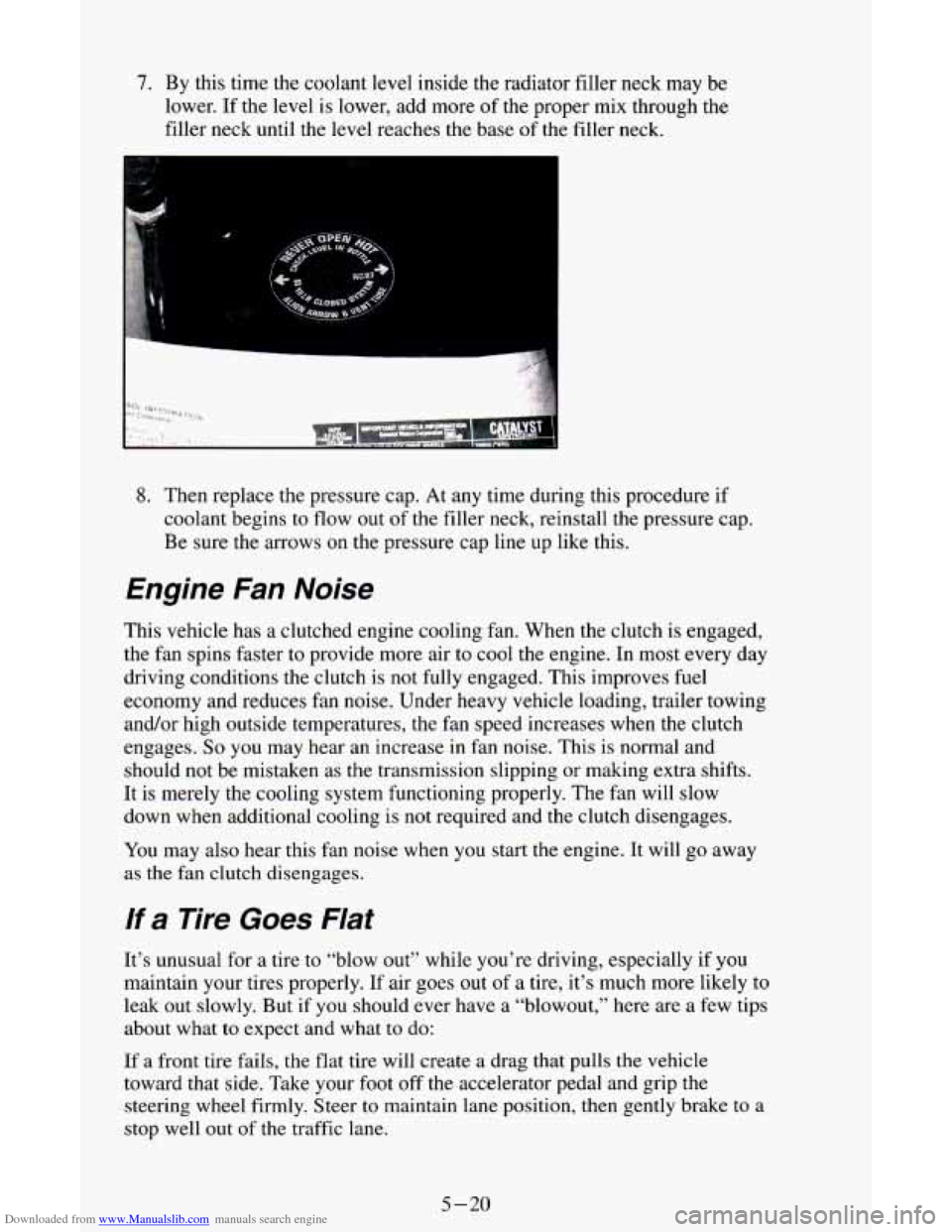Page 88 of 342

Downloaded from www.Manualslib.com manuals search engine NOTICE:
When using concentrated washer fluid, follow the
manufacturer’s instructions for adding water.
Don’t mix water with ready-to-use washer fluid. Water can
cause the solution to freeze and damage your washer fluid
tank and other parts of the washer system. Also, water
doesn’t clean
as well as washer fluid.
Fill your washer fluid tank only 3/4 full when it’s very cold.
This allows for expansion, which could damage the tank if it is
completely full.
Don’t use radiator antifreeze in your windshield washer. It
can damage your washer system and paint.
Rear Window WiperMasher - Dutch Door
You control your rear
window wipedwasher
from a switch
on your
instrument panel,
on
the driver’s side of
your steering column.
Press the top of the switch to the first position to turn on the wiper.
Press the top of the switch in all the way and hold to release the desired
amount
of washer fluid. The wipers will continue to work after you
release the switch.
0 Press the bottom of the switch (OFF) to turn the wiper off.
The rear window washer system uses
the same fluid tank as the windshield
washer system.
The rear window washer system will run out
of fluid before the windshield
washer system, indicating
you need to check your fluid level and fill the
fluid tank.
2-34
Page 187 of 342
Downloaded from www.Manualslib.com manuals search engine When you decide it’s safe to lift the hood, here’s what you’ll see:
A. Coolant recovery tank
B. Radiator pressure cap
C. Engine fan
If the coolant inside the coolant recovery tank is boiling, don’t do anything
else until it cools down.
The coolant level should be at
ADD. If it isn’t, you may have a leak in the
radiator hoses, heater hoses, radiator, water pump
or somewhere else in the
cooling system.
NOTICE:
Engine damage from running your engine without coolant isn’t \
covered by your warranty.
If there seems to be no leak, start the engine again. See if the fan speed
increases when idle speed is doubled
by pushing the accelerator pedal down.
If it doesn’t, your vehicle needs service. Turn off the engine.
5-15
Page 188 of 342
Downloaded from www.Manualslib.com manuals search engine How to Add Coolant to the Coolant Recovery Tank
If you haven’t found a problem yet, but the coolant level isn’t at ADD , add
a
50/50 mixture of clean water (preferably distilled) and a proper antifreeze
at the coolant recovery tank. (See “Engine Coolant” in the Index
for more
information about the proper coolant mix.)
NOTICE:
In cold weather, water can freeze and crack the engine, radiat\
or,
heater core and other parts. Use the recommended coolant.
I I
When the coolant in the coolant recovery tank is at ADD , start your
vehicle.
If
the overheat warning continues, there’s one more thing you can try. You
can add the proper coolant
mix directly to the radiator, but be sure the
cooling system is
cool before you do it.
5-14
Page 189 of 342
Downloaded from www.Manualslib.com manuals search engine How to Add Coolant to the Radiator
1. You can remove the radiator pressure cap when the cooling system,
including the radiator pressure cap and upper radiator hose, is
no longer
hot. Turn the pressure cap slowly
to the left until it first stops. (Don’t
press down while turning the pressure cap.)
5- 17
Page 190 of 342
Downloaded from www.Manualslib.com manuals search engine If you hear a hiss, wait for that to stop. A hiss means there is still Some
pressure left.
2. Then keep turning the pressure cap, but now push down as you turn it.
Remove the pressure cap.
3. Fill the radiator with the proper mix, up to the base of the filler neck.
5-18
Page 191 of 342
Downloaded from www.Manualslib.com manuals search engine I
4. Then fill the coolant recovery tank to ADD.
5. Put the cap back on the coolant recovery tank, but leave the radiator
pressure cap
off.
6. Start the engine and let it run until you can feel the upper radiator hose
getting hot. Watch out for the engine fan.
5-19
Page 192 of 342

Downloaded from www.Manualslib.com manuals search engine 7. By this time the coolant level inside the radiator filler neck may be
lower.
If the level is lower, add more of the proper mix through the
filler neck until the level reaches the base
of the filler neck.
8. Then replace the pressure cap. At any time during this procedure if
coolant begins to flow out of the filler neck, reinstall the pressure cap.
Be sure the arrows on the pressure cap line
up like this.
Engine Fan Noise
This vehicle has a clutched engine cooling fan. When the clutch is engaged,
the fan spins faster to provide more air to cool the engine. In most every day
driving conditions the clutch is not fully engaged. This improves fuel
economy and reduces fan noise. Under heavy vehicle loading, trailer towing
and/or high outside temperatures, the fan speed increases when the clutch
engages.
So you may hear an increase in fan noise. This is normal and
should not be mistaken
as the transmission slipping or making extra sh
It is merely the cooling system functioning properly. The fan will slow
down when additional cooling is not required and the clutch disengage .ifts.
S.
You may
also hear this fan noise when you start the engine. It will go away
as the fan clutch disengages.
If a Tire Goes Flat
It’s unusual for a tire to “blow out” while you’re driving, especially if you
maintain your tires properly.
If air goes out of a tire, it’s much more likely to
leak out slowly. But if you should ever have a “blowout,” here are a few tips
about what
to expect and what to do:
If
a front tire fails, the flat tire will create a drag that pulls the vehicle
toward that side. Take your foot off the accelerator pedal and grip the
steering wheel firmly. Steer
to maintain lane position, then gently brake to a
stop well out of the traffic lane.
5-20
Page 232 of 342
Downloaded from www.Manualslib.com manuals search engine NOTICE:
If you use an improper coolant mix, your engine could overheat
and be badly damaged. The repair cost wouldn’t be covered by
your warranty.
Too much water in the mix can freeze and crack
the engine, radiator, heater core and other parts.
Some conditions, such as air trapped in the cooling system, can affect the
coolant level in the radiator. Check the coolant level when the engine is cold
and follow the steps under “Adding Coolant” for the proper way to add
coolant.
If you have to add coolant more than four times a year, have your dealer
check your cooling system.
NOTICE:
If YOU use the proper coolant, you don’t have to add extra
inhibitors or additives which claim to improve the system. These
can be harmful.
Adding Coolant
6-24